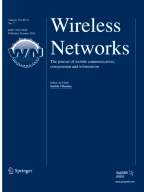Abstract
With the increasing popularity of portable wireless computers, mechanisms to efficiently transmit information to wireless clients are of significant interest. The environment under consideration is asymmetric in that the information server has much more bandwidth available, as compared to the clients. In such environments, often it is not possible (or not desirable) for the clients to send explicit requests to the server. It has been proposed that in such systems the server should broadcast the data periodically. One challenge in implementing this solution is to determine the schedule for broadcasting the data, such that the wait encountered by the clients is minimized. A broadcast schedule determines what is broadcast by the server and when. In this paper, we present algorithms for determining broadcast schedules that minimize the wait time. Broadcast scheduling algorithms for environments subject to errors, and systems where different clients may listen to different number of broadcast channels are also considered. Performance evaluation results are presented to demonstrate that our algorithms perform well.
Similar content being viewed by others
References
S. Acharya, M. Franklin and S. Zdonik, Dissemination-based data delivery using broadcast disks, IEEE Personal Communication (December 1995) 50-60.
C.C. Aggarwal, J.L. Wolf and P.S. Yu, The maximum factor queue length batching scheme for video-on-demand systems, Technical Report RC 20621, IBM T.J. Watson Research Center (November 1996).
M.H. Ammar and J.W. Wong, The design of teletext broadcast cycles, Performance Evaluation 5 (November 1985) 235-242.
M.H. Ammar and J.W. Wong, On the optimality of cyclic transmission in teletext systems, IEEE Transactions on Communications (January 1987) 68-73.
S. Banerjee and V.O.K. Lee, Evaluating the distributed datacycle scheme for a high performance distributed system, Journal of Computing and Information 1 (May 1994).
S. Banerjee, V.O.K. Lee and C. Wang, Distributed database systems in high-speed wide-area networks, IEEE Journal on Selected Areas in Communications 11 (May 1993) 617-630.
A. Bar-Noy, R. Bhatia, J. Naor and B. Schieber, Minimizing service and operation costs of periodic scheduling, Technical Report, Tel Aviv University (1997).
T.F. Bowen et al., The datacycle architecture, Communications of ACM 35 (December 1992) 71-81.
T. Chiueh, Scheduling for broadcast-based file systems, in: MOBIDATA Workshop(November 1994).
A. Datta, A. Celik, J.G. Kim, D.E. VanderMeer and V. Kumar, Adaptive broadcast protocols to support efficient and energy conserving retrieval from databases in mobile computing environments, in: Data Engineering Conference(April 1997).
J. Gescei, The Architecture of Videotex Systems(Prentice-Hall, Englewood Cliffs, NJ, 1983).
G. Herman, G. Gopal, K.C. Lee and A. Weinrib, The datacycle architecture for very high throughput, in: Proc. of ACM SIGMOD(1987).
T. Imielinski, S. Viswanathan and B.R. Badrinath, Energy efficient indexing on air, in: International Conference on Management of Data(May 1994) pp. 25-36.
T. Imielinski, S. Viswanathan and B.R. Badrinath, Data on the air-organization and access, IEEE Transactions of Data and Knowledge Engineering (July 1996).
R. Jain and J. Werth, Airdisks and airraid: Modelling and scheduling periodic wireless data broadcast (extended abstract), DIMACS Technical Report 95-11, Rutgers University (May 1995).
S. Jiang and N.H. Vaidya, Scheduling algorithms for a data broadcast system: Minimizing variance of the response time, Technical Report 98-005, Computer Science Department, Texas A&M University, College Station (February 1998).
C.J. Su and L. Tassiulas, Broadcast scheduling for the distribution of information items of unequal length, Technical Report, Institute for Systems Research, University of Maryland (1997).
N.H. Vaidya and S. Hameed, Data broadcast scheduling: On-line and off-line algorithms, Technical Report 96-017, Computer Science Department, Texas A&M University, College Station (July 1996).
N.H. Vaidya and S. Hameed, Scheduling data broadcast in asymmetric communication environments, Technical Report 96-022, Computer Science Department, Texas A&M University, College Station (November 1996).
S. Viswanathan, Publishing in wireless and wireline environments, Ph.D. thesis, Rutgers (November 1994).
J.W. Wong, Broadcast delivery, in: Proceedings of IEEE(December 1988) pp. 1566-1577. Nitin Vaidya received the Ph.D. degree from the University of Massachusetts at Amherst in 1992. He previously received M.E. and B.E. (Hons) degrees from the Indian Institute of Science, Bangalore, and the Birla Institute of Technology and Science, Pilani, respectively. He is currently an Associate Professor of Computer Science at the Texas A&M University. His research interests include networking, mobile computing and fault-tolerant computing. Nitin Vaidya is a recipient of a 1995 CAREER award from the National Science Foundation. He has served on program and organizing committees of several conferences. He is a member of the ACM and the IEEE Computer Society. E-mail: vaidya@cs.tamu.edu Sohail Hameed received a B.S. in computer engineering from NED University of Engineering and Technology, Pakistan, and an M.S. in computer science from Texas A&M University at College Station. He is currently a systems engineer at Compaq Computer Corporation. His research interests include broadcast scheduling and highreliability mass-storage system design. He is an associate member of the IEEE.
Author information
Authors and Affiliations
Rights and permissions
About this article
Cite this article
Vaidya, N.H., Hameed, S. Scheduling data broadcast in asymmetric communication environments. Wireless Networks 5, 171–182 (1999). https://doi.org/10.1023/A:1019142809816
Issue Date:
DOI: https://doi.org/10.1023/A:1019142809816
